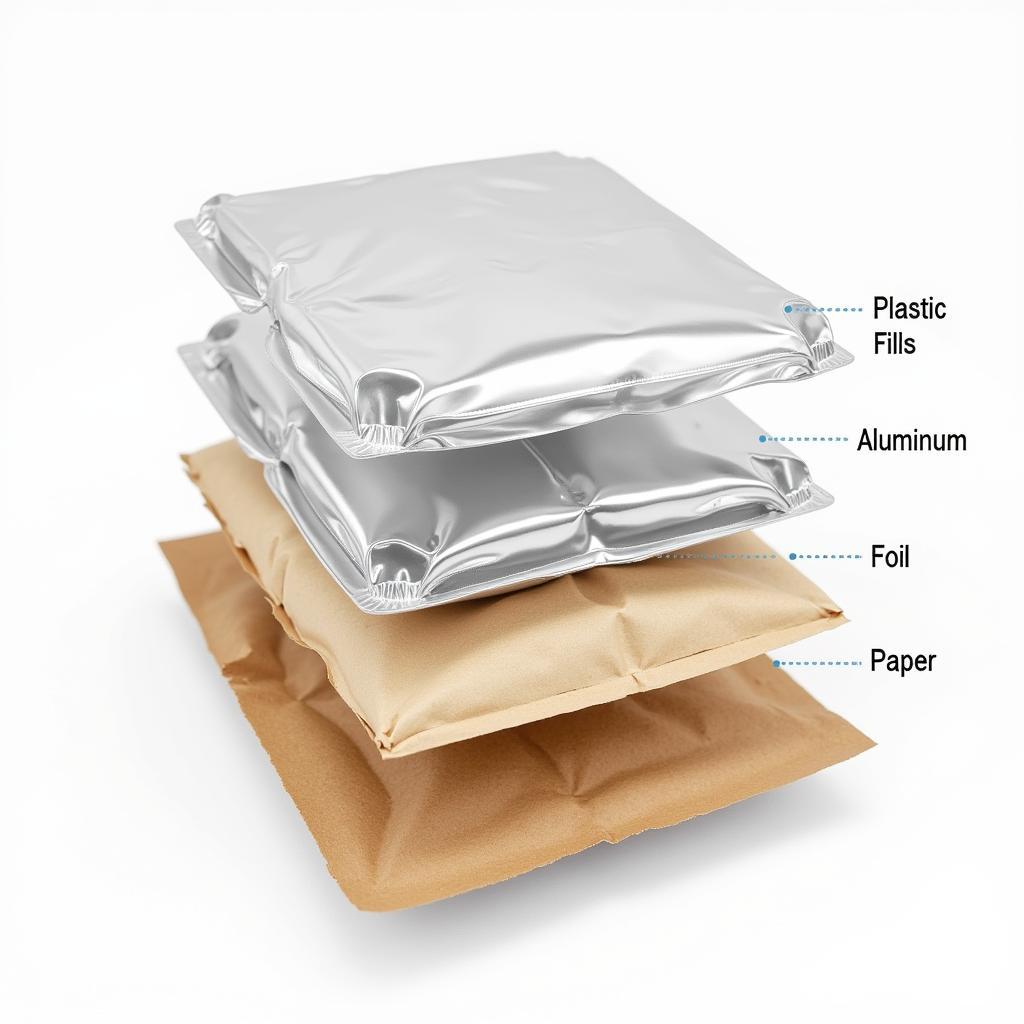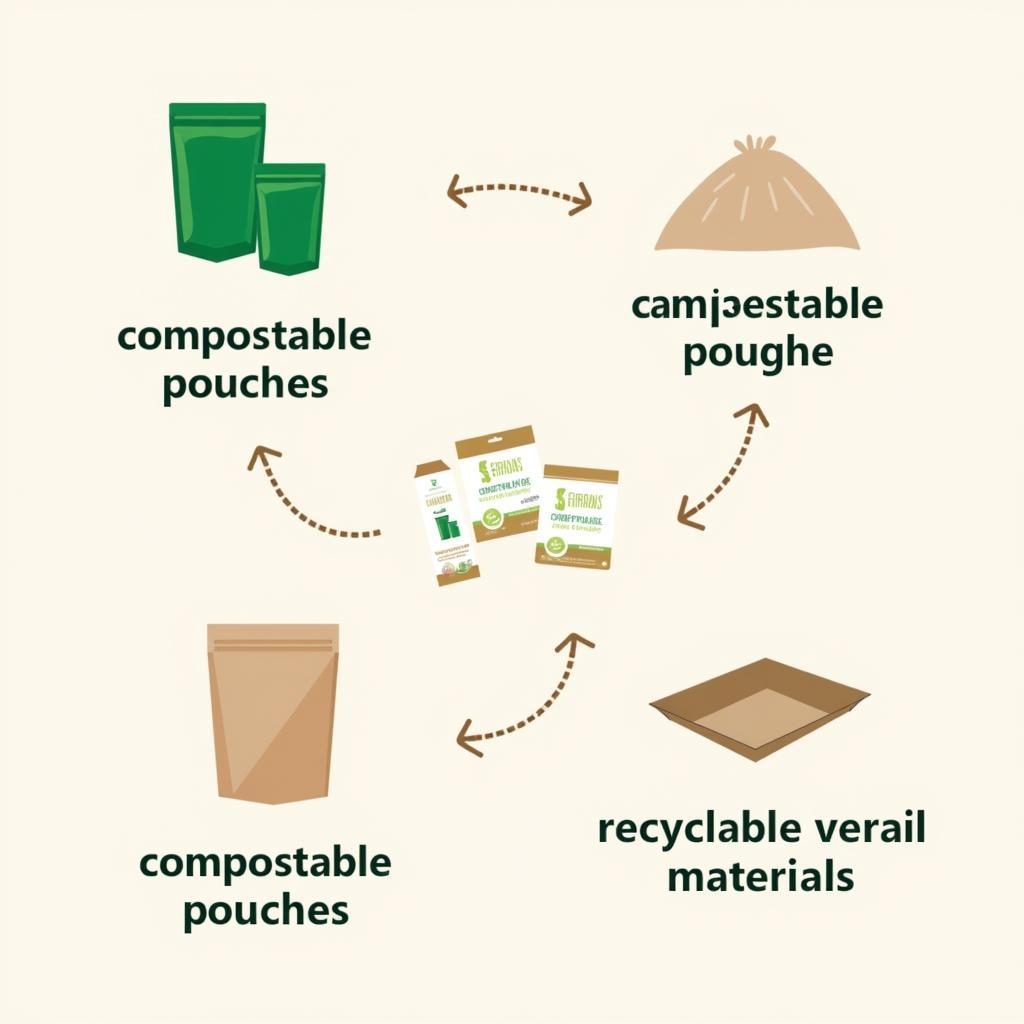Laminate Food Packaging is a ubiquitous part of our modern lives, protecting everything from potato chips to coffee beans. But what exactly is it, and why is it so crucial for food safety and preservation? This guide dives deep into the world of laminate food packaging, exploring its benefits, different types, and its role in the future of food.
Understanding Laminate Food Packaging
Laminate food packaging involves combining multiple layers of different materials to create a robust and protective barrier for food products. These layers can include plastics, paper, aluminum foil, and other specialized films.  Laminate Food Packaging Layers Each layer contributes specific properties, such as strength, moisture resistance, oxygen barrier, and printability. This multi-layered approach allows manufacturers to tailor the packaging to the specific needs of the food product, ensuring optimal freshness and shelf life. Think about your favorite packaging for dog food – chances are, it uses some form of lamination to keep it fresh and appealing.
Laminate Food Packaging Layers Each layer contributes specific properties, such as strength, moisture resistance, oxygen barrier, and printability. This multi-layered approach allows manufacturers to tailor the packaging to the specific needs of the food product, ensuring optimal freshness and shelf life. Think about your favorite packaging for dog food – chances are, it uses some form of lamination to keep it fresh and appealing.
Why is Lamination Necessary?
Food spoilage is a major concern for both consumers and producers. Lamination provides a crucial defense against factors that contribute to spoilage, like moisture, oxygen, light, and pests. For example, heat seal food bags often utilize lamination to create a strong, airtight seal.
Types of Laminate Food Packaging
Various types of laminate food packaging cater to different food products and requirements. Some common examples include:
- Retort Pouches: These pouches are designed for sterilized foods and can withstand high temperatures during processing.
- Stand-up Pouches: With their convenient design, stand-up pouches are popular for snacks, liquids, and other products.
- Vacuum Pouches: By removing air from the package, vacuum pouches extend the shelf life of perishable foods.
- Lidding Films: These films are used to seal containers and trays, providing a tamper-evident and protective layer.
What are the Benefits of Using Laminate Food Packaging?
The advantages of laminate food packaging are numerous:
- Extended Shelf Life: By creating a barrier against external elements, lamination helps to preserve food quality and extend its shelf life.
- Enhanced Product Protection: The robust nature of laminate packaging protects food from damage during transportation and handling. Have you considered how important this is for your pul fabric food safe products?
- Improved Aesthetics: Laminate packaging offers excellent printing capabilities, allowing for attractive branding and product information. Consider how eye-catching food truck stickers can be!
- Reduced Waste: Compared to some traditional packaging methods, laminate packaging can be lighter and more compact, minimizing waste.
“Laminate packaging is essential for protecting the integrity and quality of food products, especially in today’s global supply chain,” says Dr. Emily Carter, a food science expert.
The Future of Laminate Food Packaging
The laminate food packaging industry is constantly evolving. Research and development focus on creating sustainable and eco-friendly packaging solutions, including biodegradable and compostable options.
Is Laminate Food Packaging Sustainable?
The sustainability of laminate food packaging is a complex issue. While traditional laminate structures can be challenging to recycle, innovative solutions are emerging, such as mono-material laminates and recyclable pouches.
“The future of food packaging lies in developing sustainable materials and promoting responsible disposal practices,” adds Dr. Carter.  Sustainable Laminate Food Packaging If you’re wondering, “is pul fabric food safe,” lamination plays a key role in making these materials suitable for food contact.
Sustainable Laminate Food Packaging If you’re wondering, “is pul fabric food safe,” lamination plays a key role in making these materials suitable for food contact.
Conclusion
Laminate food packaging plays a vital role in preserving food quality, extending shelf life, and enhancing product presentation. As technology advances, the industry is increasingly focused on developing sustainable and environmentally friendly packaging solutions to meet the evolving needs of consumers and the planet.
FAQ
- What is laminate food packaging made of?
- Is laminate food packaging recyclable?
- What are the different types of laminate food packaging?
- What are the benefits of using laminate food packaging?
- How is laminate food packaging used for different food products?
- What are the environmental concerns associated with laminate food packaging?
- What are the future trends in laminate food packaging?
For further assistance please contact Phone Number: 02437655121, Email: minacones@gmail.com Or visit us at: 3PGH+8R9, ĐT70A, thôn Trung, Bắc Từ Liêm, Hà Nội, Việt Nam. We have a 24/7 customer service team.